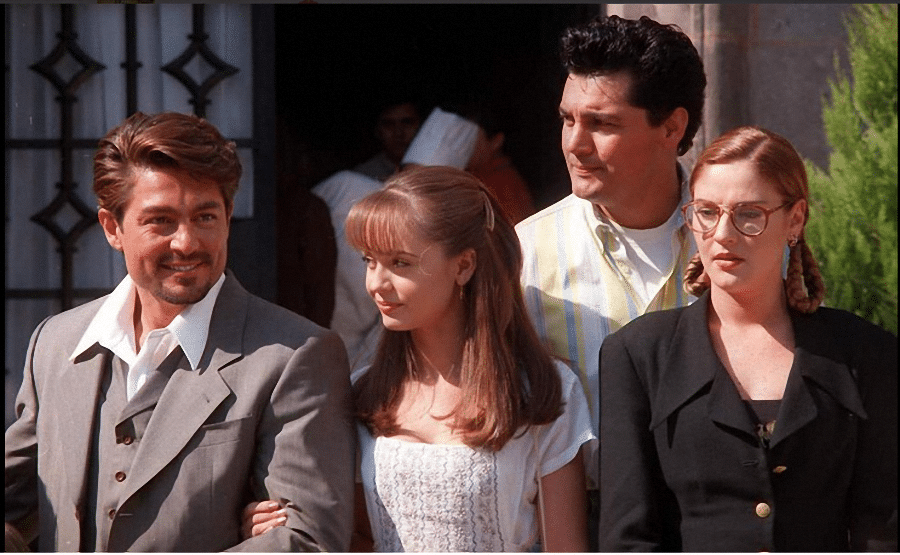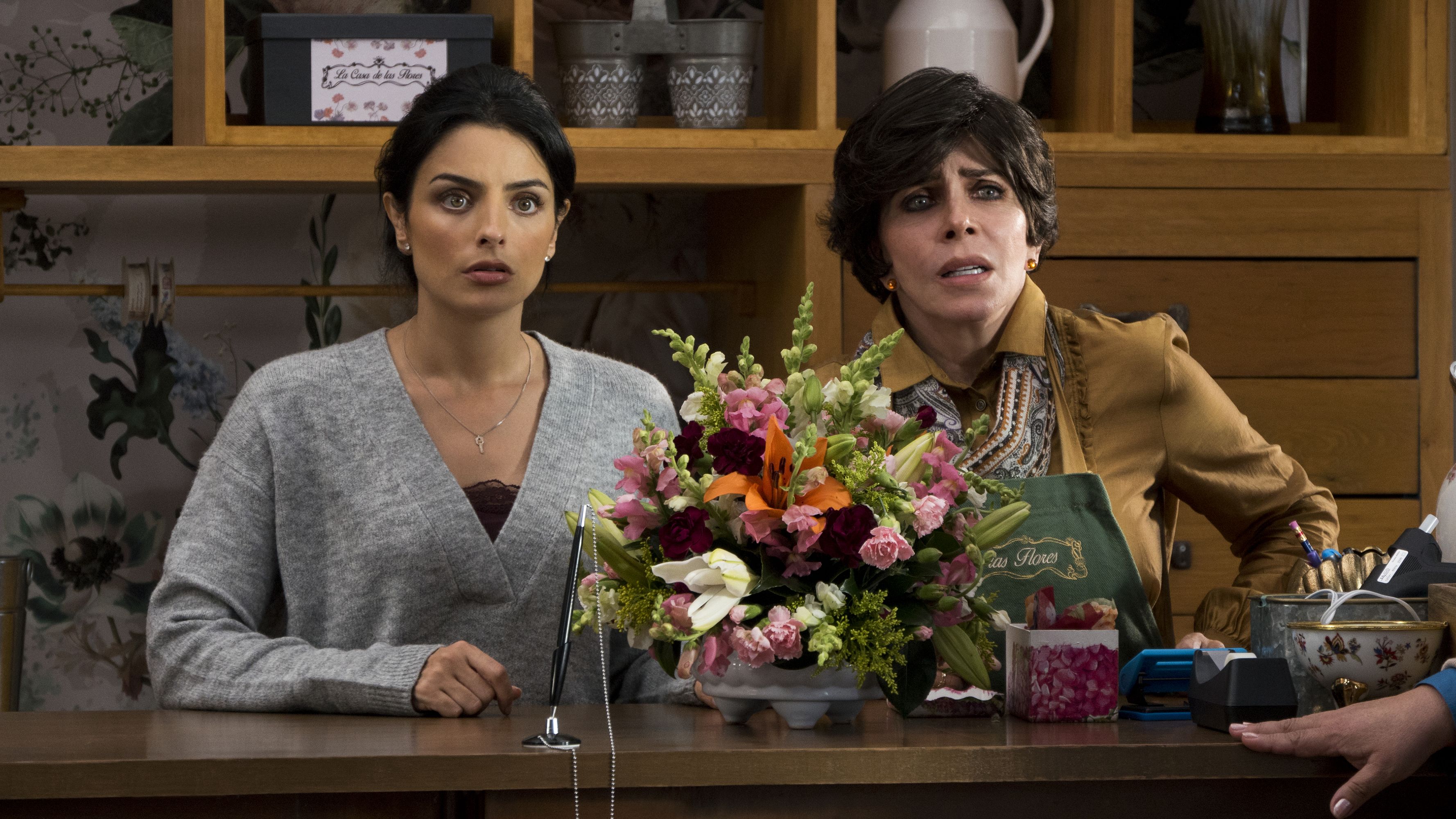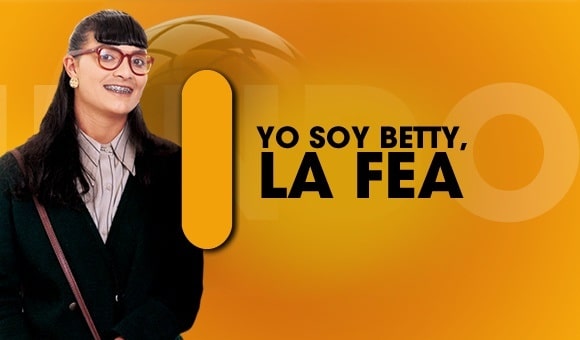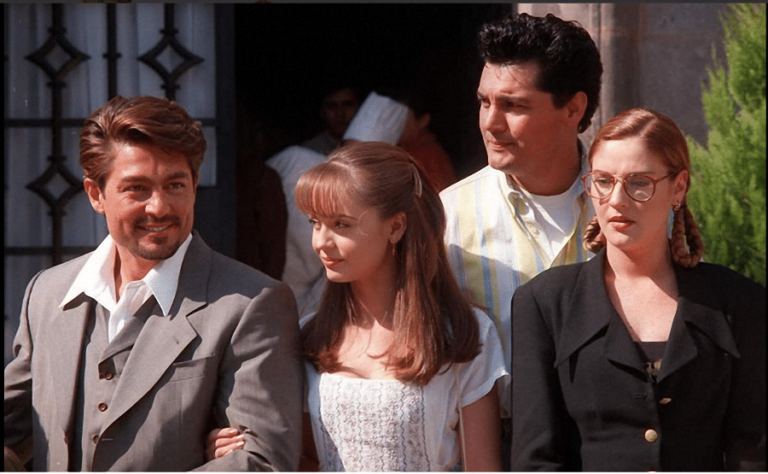
Hearing the lyrics of a Spanish song and just passing Spanish brands at the supermarket gave you the tingles.
So, you promised to learn this seductive language at any cost.
You’ve listened to the audiobooks, surfed the YouTube channels and interacted with native speakers at every possible opportunity.
But if you’re looking for something fun to significantly boost your Spanish, read on to get into the exciting world of telenovelas!
Contents
Download:
This blog post is available as a convenient and portable PDF that you
can take anywhere.
Click here to get a copy. (Download)
What Do Telenovelas Have to Offer?
A telenovela deals with the roller coaster ride of life, and staple topics include family, marriage, politics and business.
The themes often revolve around the four Rs: romance, revenge, redemption and rivalry.
With telenovelas, anything is possible—the dead come back to life, a long-lost evil twin suddenly appears and anybody can get amnesia. Even star-crossed lovers can turn out to be brother and sister.
Boom! You’ve got a highly addictive plot and subplots with twists and turns that can glue you to your seat for hours. (You’ve been warned.)
Many people think that telenovelas and soap operas are the same things, but they’re actually different in several aspects:
- Telenovelas have a closed narrative, while soap operas are open. This simply means that while telenovelas have a specific story to tell with a beginning and an established end, soap operas have no particular goal or end, and they go on for as long as they have viewers.
- Because of this open vs closed narrative, telenovelas tend to have a faster pace than soap operas. What happens in a day in a telenovela could easily take one whole week or even two in a soap opera.
- As a result, telenovelas last around 12-18 months, while soap operas can run for years (sometimes decades!)
- Telenovelas have one main villain, the antagonist who tries to destroy the main protagonist’s life at all costs. Soap operas, on the other hand, have so many characters who come and go and so many intertwined lives that they need several villains.
- Finally, telenovelas are dramatic, over-the-top and flashy. Everything humanly possible can happen. A simple example: A man falls in love with his maid, who turns out to be his lost half-sister because the woman who was her husband’s brother’s lover got pregnant, but to save her reputation, she left her child in an orphanage. Are you lost yet? Me too, but you get the gist.
On the other hand, soap operas tend to be either realistic to the fullest (like “Grey’s Anatomy”) or supernatural from beginning to end, with magic, demons, ghosts, witches, werewolves and vampires all over the place. Rest assured, you’ll never see a werewolf in a telenovela.
A word you may have also heard is novela.
If you look up this word in a dictionary, the first definition will always be “short novel” or “novella.” However, some good dictionaries also include another definition: “soap opera.”
We’ve seen that telenovelas and soap operas are actually quite different, but it’s true that the word novela is very commonly used to refer to telenovelas.
As a personal anecdote, I can tell you that in the region where I was born (Andalusia, Spain), everybody refers to telenovelas as novelas. If you haven’t heard the sentence “Ya empieza la novela” (The telenovela is starting), you haven’t really felt what living with a Spanish family means.
The Best Telenovelas for Spanish Learners
In terms of learning Spanish, there’s nothing more effective, more engaging and more culturally nuanced. So if you’re looking to make your Spanish lessons come alive, look no further.
Here are 16 telenovelas that are your tickets to learning Spanish with a ton of dramatic scenes and cliffhangers galore. Watch at your own risk!
1. “María la del barrio” (“María of the Neighborhood”)

Having aired in 180 countries, “María la del barrio” is one of the most popular telenovelas to hit the TV screen.
Starring the effervescent Thalía (of “Marimar,” “María Mercedes” and “Rosalinda” fame), the show tells the story of a young, impulsive scavenger who’s welcomed inside the mansion of a wealthy family and promptly falls in love with one of the sons (Fernando Colunga as Luis Fernando) of her benefactor.
But with any Thalía show, or any telenovela for that matter, love never comes easy for two star-crossed lovers.
A scheming, back-stabbing and really crazy Soraya, is just around the corner to foil any attempts at happiness made by our favorite duo.
Remember what I said about telenovelas? Anything is possible.
“María la del barrio” takes the cake, featuring faked deaths, staged pregnancies, mistaken identities, sly gossip, stints in prison and the asylum, rags-to-riches-to-rags-again plot twists, amnesia, adoption and brother and sister dating.
With “María la del barrio,” you’re not just learning the language, you’re also learning it with the context and force of passion, despair, revenge and hope.
2. “La mentira” (“The Lie”)

“La mentira” tells the story of Demetrio who, returning from a stint in Europe, comes home to his family’s tequila plantation in Mexico where he discovers that his brother, Ricardo, has committed suicide.
Among his brother’s possessions, he finds a letter from a mysterious woman detailing how she never really loved Ricardo and that she’s getting married to someone else, how she aborted their child and how she spent all his money. He realizes that she was the cause of his death.
In addition to the letter, he also finds a V-shaped broach which he thinks belongs to the very woman who drove his brother to end his life.
From that very moment, Demetrio resolves to avenge his brother’s death.
The mission brings him to the house of the Fernández-Negrete family—the owners of one of the most illustrious banks in Mexico—where he meets the cousins named Virginia and Veronica. (Remember the V-shaped broach? He’s getting warm.)
Virginia is kind-hearted and innocent, while Veronica is confident and somewhat sneaky. Through a series of incidents, Demetrio is led to believe that it’s Veronica that he’s been looking for. He then puts into motion plans for making her life extra-miserable to avenge his brother’s death.
You’ll be left screaming Spanish words and phrases towards your computer monitor. And that’s how you’ll learn Spanish along the way.
3. “Te sigo amando” (“I Still Love You”)

“Te sigo amando” is a story of forbidden love. (Surprise, surprise!)
It stars Claudia Ramírez as Yulissa Torres-Quintero—a beautiful and innocent young lady forced to marry a rich landowner because of her family’s debts.
On the day of their wedding, Ignacio Aguirre, the rich husband, suffers an accident that leaves him unable to consummate the marriage. His sorry condition leaves him a bitter and hard man.
This story wouldn’t be complete without a handsome doctor to complete the love triangle.
Doctor Luis Ángel Zaldívar, a renowned physician, goes on a house call that will change his life forever. The first time he sees Claudia, sparks almost engulf the room.
Claudia is only too helpless from falling in love with the dashing doctor. The two get into an amorous relationship which results in a pregnancy.
What fate awaits Claudia and her baby? Why don’t we ask Ignacio Aguirre and his mustache, which has a starring role in almost all of his scenes?
4. “Rebelde Way” (“Rebel’s Way”)

Are you up for some Argentinian teen telenovela time? I give you “Rebelde Way” —a story about the lives of teenagers hailing from Argentina’s wealthiest families.
The setting is the Elite Way School, a private boarding school that’s witness to the youthful delinquencies of Marizza, Mía, Pablo and Manuel.
The four share a passion for music and, in spite of their initial differences, they decide to form the band called Erreway.
And would you believe it, there’s actually a band called Erreway whose members are the very same actors and actresses in the telenovela. In fact, the actual band has released several platinum records and has toured Latin America, Europe and Israel.
The accompanying telenovela was so successful that it spurred a number of international remakes, the most popular of which is Mexico’s “Rebelde.”
Don’t be too swayed by the telenovela’s charismatic and highly relatable characters. Remember, you’re doing this to learn a language, so be on the lookout for Spanish language cognates, which are words that are similar in English and Spanish.
5.“Corazón salvaje” (“Wild Heart”)

“Corazón salvaje,” which won Best Telenovela of the Year in 1994, is the story of gruff Juan del Diablo, who grew up fatherless on the streets of San Pedro. It turns out that he’s actually the love child of wealthy landowner Francisco Alcázar.
As is the tradition of telenovelas, this is a journey of romance and rivalries, of deception and broken promises. But I included this show on the list not for these reasons.
“Corazón salvaje” is set in the 1900s. As such, the characters speak in a kind of Spanish reminiscent of that era. The language is slightly elevated, subtly majestic.
Though their costumes might prove a little bit distracting, once you get over it, “Corazón salvaje” is good practice for language learners who aim for a deeper mastery of Spanish.
6. “Catalina y Sebastián” (“Catalina and Sebastián”)

Let’s say you’re a very rich rancher and you want to know if a woman married you for love or for money. What would you do?
You’ll pose as a poor workman, right? If she still loves you in spite of that, then you know she’s not interested in the cha-ching. This is exactly what happens in “Catalina y Sebastián.”
Sebastián, the male protagonist, does more than that. He presents himself as a rich rancher. Then, after the wedding, he makes it look like he was only a poor workman who duped his bride into marrying him. (Sebastián, in actuality, has mucho dinero. )
When he discovers that Catalina only married him to be in the lap of luxury, he plots revenge by refusing to divorce her and making her live in daily poverty.
Unfortunately or fortunately, through their interactions as husband and wife, Catalina starts to have real feelings for him.
Now, though, she’s in too deep. Not only does her husband Sebastián not trust her, but another man is holding Sebastián’s money and ranch hostage unless Catalina agrees to marry him, instead. How far will Catalina go to help Sebastián? Is money worth more than love?
7. “La Reina del Sur” (“The Queen of the South”)

“La Reina del Sur” chronicles the rapid rise of underworld queen Teresa Mendoza, a Mexican diva who uses her womanly wits to take over Spain’s illegal drug industry.
In her home country, her thug of a boyfriend gets wasted and she goes on the lam. As an expat, she juggles international intrigue, flings with sexy lowlifes and rules her burgeoning drug empire without ever missing a beat. And she does it all in high heels.
Sure, Mexican and Spanish accents can pose problems for newcomers to the Spanish language—but no matter what your level of Spanish is, you’ll find yourself adjusting quickly to these regional sounds.
The story is primarily action-driven, so you’ll understand what’s going on thanks to the strong visual element of the show.
With some of the highest production costs of any telenovela, you’ll see why so many people have become positively engrossed in Teresa’s tale.
8. “Pasión de Gavilanes” (“Hidden Passion,” lit. Passion of Hawks)

“Pasión de Gavilanes” is probably one of the most popular Colombian telenovelas of the past 20 years.
It begins with a tragic bang: A young woman falls in love with a rich older man, the man dies in a horse accident and the woman, who’s just found out she’s pregnant, commits suicide.
At this point, the six main characters of the story appear.
On the one hand, you have the three handsome-as-gods Reyes brothers. They’re the young woman’s brothers, and although they’re good and humble, they decide to seek revenge for the death of their sister. Drama!
On the other hand, you have the three beautiful-as-goddesses Elizondo sisters, who are the late rich man’s daughters.
The Reyes brothers decide they’re going to make the Elizondo sisters fall in love with them, then break their hearts and leave them.
But there’s a problem the Reyes brothers didn’t foresee: They fall in love with the three sisters. Imagine what would happen if the three sisters found out about the revenge plan!
Well, you don’t have to imagine. Just watch this amazing telenovela and you’ll see for yourself.
9. “Reina de corazones” (“Queen of Hearts”)

“Reina de corazones” is a rollercoaster of emotions from the get-go.
It takes place in Las Vegas, and it tells the story of Reina. Picture this: Reina, a beautiful, humble woman, falls in love with a handsome womanizer, Nicolás, who has a girlfriend, Camila.
Fortunately for Reina, it’s love at first sight—so powerful that they decide to get married right away. This is not so fortunate for shunned ex-girlfriend Camila, who’s so distraught at being dumped that she kills herself.
Skip ahead to the wedding day. Camila’s father, Víctor, quite understandably wants Nicolás dead.
Víctor is a bad man, a gem trafficker with terrorist connections and power over a lot of people. His men, obviously, follow his orders and go looking for Nicolás, who gets shot.
Meanwhile, Reina waits impatiently for Nicolás to come to the wedding ceremony, but he never does because, well, he’s busy dying.
Fast-forward to Reina having an accident and forgetting the past eight years of her life. Wait, what? Yes, that’s right! You were warned that telenovelas are a wild ride.
Reina is now married to Víctor and has a daughter, all of which is news to her. And she doesn’t even remember being in love with Nicolás!
Just when you thought it couldn’t get any stranger, enter Javier, who looks suspiciously similar to Nicolás.
I can’t tell you anything else without spoiling the story, but trust me, you’re in for a lot of unexpected twists. Give it a watch!
10. “La usurpadora” (“Deceptions,” lit. The Usurper)

“La usurpadora” is one of my all-time favorite telenovelas, and if you watch it, you’ll understand why.
It tells the story of Paola and Paulina, twin sisters who were separated at birth. Paulina is a good, humble woman whose fiancé has a mistress, while Paola is a vain woman married to a rich man (Carlos Daniel) who she doesn’t love.
One day, Paola’s and Paulina’s paths cross. They don’t know they’re twin sisters, but since they’re so strikingly similar, physically, Paola creates a plan in which Paulina is going to substitute her at home for a year while she goes to Monaco with her lover.
For reasons I don’t want to tell you, Paulina accepts.
When she arrives at Paola’s place, the situation is a real mess: an unloving husband, a neglected child, a hating sister-in-law, several lovers… Paulina’s life becomes a turmoil she’s barely able to handle, while her twin sister is off having fun who knows where.
Time goes by. Paulina manages to convince everyone she’s the same person but she’s changed. At this point, Paola decides to go back to her place, and chaos ensues. There are further cases of mistaken identity, a blossoming love that’s not to be, a (failed) attempt to feign disability in a wheelchair… And so, so much more!
If you want to find out how this ends, you’ll have to grab some popcorn and watch it.
“La usurpadora” is the quintessence of what a real telenovela is, and I can’t recommend it enough. There’s also a 2019 remake available to watch if you prefer that version!
11. “La reina del flow” (“The Queen of Flow”)

If you love the drama that comes with telenovelas and the hypnotizing rhythm of reggaeton, then you’re going to love “La reina del flow.”
Yeimy Montoya is a 16-year-old Colombian teenager who writes reggaeton lyrics she keeps hidden in a secret notebook. Her parents own a small bakery, but they get killed because they refuse to pay a “protection bribe” to the local narco.
Soon after that, she becomes part of her high-school reggaeton group and, after being broadcast on the local radio, they all get to go to New York City to meet a music producer. Unfortunately, tragedy strikes in New York, and Yeimy gets wrongfully sentenced to 25 years in prison.
While she’s in prison trying to cope with her new reality, someone finds her secret notebook and uses her lyrics to become a famous reggaeton artist. This person goes on to create a successful production studio thanks to Yeimy’s lyrics.
When she’s released from prison 17 years later, an attempt is made on Yeimy’s life. However, she survives and, presumed dead, decides to return to Colombia and seek revenge for everything that’s happened to her and her family.
Watch the show to find out what happens next!
12. “La casa de las flores” (“The House of Flowers”)

Even though “La casa de las flores” is a Netflix original, you’ll understand in a second why I’ve decided to add it to this list.
In case you haven’t heard, there’s a kind of new genre called “millennial telenovela.” Also sometimes called a “modern telenovela,” millennial telenovelas are basically telenovelas created for millennials.
A millennial telenovela features younger characters, positive LGBTQ+ representation and other aspects that can appeal to a younger audience. All in all, these shows pretend to be a satirical representation of the classical telenovela while keeping its core traits, i.e. the four Rs: romance, revenge, redemption and rivalry.
“La casa de las flores” is a perfect example of the millennial telenovela. It shows the life of a wealthy Mexican family, the de la Mora family, who owns a flower shop.
The show starts in a very promising way: It’s the family patriarch Ernesto de la Mora’s birthday. In typical wealthy family fashion, the birthday party is huge and the number of guests is close to infinity.
During this party, Ernesto’s mistress hangs herself. (Yes, we’re just minutes into the series and we already have a dead mistress. Now tell me this isn’t a telenovela.)
What follows next is a wonderful web of chaos.
Ernesto gets sent to prison for fraud. His son Julián comes out as bisexual. His daughter almost gives Virginia, the matriarch, a heart attack by revealing she owns a cabaret with the same name as the floristry shop (The House of Flowers, hence the name of the show).
Another daughter is hiding a secret African-American fiancé. Virginia’s ex-husband, who’s now a woman, is asked to represent Ernesto as his lawyer. The family’s accountant is secretly Julián’s boyfriend.
As you can see, it’s a hot mess you shouldn’t be missing!
I love how the series manages to keep the telenovela atmosphere while subverting its most intrinsic stereotypes in a tragicomic way. So if you enjoy black humor and dramedies, “La casa de las flores” will be your next favorite show.
13. “Yo soy Betty, la fea” (“Ugly Betty,” lit. I Am Betty, the Ugly One)

Next on our list is “Yo soy Betty, la fea” —an unassuming but extraordinarily well-known global phenomenon.
While watching “Ugly Betty” in high school and college, some friends of mine who were learning Spanish immediately gravitated to this familiar story. You’ve just gotta love watching Betty’s journey from homely to fabulous, an aspect that’s explored far more in the original series than the American remake.
The original Betty is also a bit more hardcore—she’s surrounded by scandals that would shock and horrify America Ferrera’s Betty—and she hits us with unexpected doses of realism at every turn.
The resolutions of this Betty’s corporate climbing and relationship endeavors tend to be anything but fairy-tale perfect. On the bright side, this all balances out with tons of goofy, cheeseball humor and catty (but silly) can-you-believe-she-wore-that comments.
The sing-song Colombian accents, along with regional slangs, may toss you a curveball. However, it’s relatively similar to many other Latin American accents, and you’ll find it easier to understand the more you watch.
14. “A corazón abierto” (“With an Open Heart”)

Longing for the good old days of dark and twisty “Grey’s Anatomy” drama? “A corazón abierto” is the telenovela for you.
Now’s your chance to recapture that magic. I was pleasantly surprised to discover that this show was modeled on “Grey’s Anatomy” in almost every way—even the characters look nearly identical to the Grey’s cast.
In keeping with the spirit of the original program, “A corazón abierto” is the perfect confluence of medical and emotional. You’ve got the dark ambiance, meaningful stares, personal trials and doctor-on-doctor relationship dynamics.
You’ll ride along with these doctors-in-training as they run up against ethical dilemmas, medical mishaps, intrigue surrounding mysterious diseases and major learn-the-hard-way moments.
Beginners may not catch all the details of ongoing procedures and what-not, but will definitely be able to keep up with the personal issues and interpersonal dramas—and, honestly, that’s really what we came to see, right?
15. “Una familia con suerte” (“A Lucky Family”)

This classic rags-to-riches story is guaranteed to win you over from episode #1. Do you love crude, vulgar Mexican street talk? A bit of heartwarming family humor? Stop right here give “Una familia con suerte” a try.
Pancho López is undeniably likable, a humble widower and doting father just trying to make ends meet. To top it off, he persuades a suicidal woman to come down off a bridge and see the value in her life. As fortune would have it, she’s a wealthy business executive.
When Pancho’s family is about to lose everything due to financial hardship, she steps in and changes their lives overnight. Reluctant to accept her “charity,” but in dire need nonetheless, Pancho hesitantly accepts her job offer to become the president of her company and moves his family into her mansion.
Worlds collide, star-crossed lovers meet, yada yada—all in all, this show has a lot of great things to say about humanity and how people from different social strata interact.
Advanced learners will revel in the abundance of Mexican slang and ultra-thick accents. Beginners will have to acclimate, but catching the major take-home messages should pose no major problem.
16. “Por ella soy Eva” (“For Her I’m Eva”)

This little number, “Por ella soy Eva,” overtook “Una familia con suerte.” The premise is, if you can believe it, even more far-fetched.
Juan Carlos is a womanizing playboy who falls in love for the first time and, predictably, bungles it all up. Can he have a second chance?
Well, in this universe of telenovela meets “Mrs. Doubtfire,” of course he can.
When business adversaries attempt to murder him, he fakes his own death, transforms himself into a woman, and starts work as his ex-girlfriend’s assistant. You can probably see where it’ll all go from there, but the journey is pretty hilarious to watch anyway.
This one is perfect for all levels of Spanish language learners. Its bombastic, slapstick, Mars-versus-Venus humor is quite easy to follow.
How to Learn Spanish with Telenovelas
As you have seen above, there are so many telenovelas to choose from, and as a learner of Spanish, they are one of the best tools you can use to improve your language skills.
Telenovelas allow you to practice the variety of Spanish you want to learn. There are so many that you’d need five lifetimes to watch them all, so be picky and choose the ones that’ll really help you study the accent you’re trying to learn.
Believe it or not, telenovelas are also great conversation starters. If two or more people are watching the same telenovela, chances are they’ll end up talking about it and wondering what’s going to happen next.
Finally, telenovelas are native content. This is content that’s made by native Spanish speakers for native Spanish speakers, which means you’re seeing the language in a form that’s as authentic as it gets. Native content exposes you to the language as it’s spoken in real life and shows you how to actually apply textbook and classroom learning to real Spanish speech.
All this means that telenovelas are perfect for improving your Spanish vocabulary, grammar, rhythm and intonation, among other skills.
If we mix these three reasons together and add a bit of imagination, we can actually take advantage of watching telenovelas in several specific ways.
Here are some ideas:
Re-watch selected episodes
If there’s an episode you’ve enjoyed or one you didn’t quite understand, watch it again. Write down the words you don’t recognize and create flashcards with them.
Practice Spanish shadowing
Shadowing is one of the best ways to learn Spanish and acquire a great native accent. Use the telenovelas included in this post to practice shadowing and your speaking skills will skyrocket.
The practice of shadowing is best used with a resource that has an accurate transcript or subtitles.
Switch on the Spanish subtitles
At least at the beginning, always have the Spanish subtitles on. This will be helpful if you get lost or don’t understand what the characters are saying. Besides, your brain will be getting double the input (through your ears and through your eyes), so you’ll actually be practicing two language skills at once.
Not all resources have Spanish subtitles available and those that do might not necessarily have accurate ones. To get around this issue, you can use a language learning program like FluentU, which uses expert-vetted subtitles in English and Spanish (both of which can be toggled on or off easily).
FluentU has a selection of authentic videos like a trailer for “30 Coins,” HBO’s drama with a novela twist, as well as clips from TV shows like the Colombian soap opera “The Hypochondriac” and other real Spanish content.

FluentU also has multimedia transcripts and flashcards, review exercises that test typing and speaking skills and other features that can be useful for Spanish language learners.
You can access the program in your browser or on the iOS and Android apps.
At the end of the day, subtitles are what you make of them. You don’t want to rely too much on English captions, but the addition of Spanish subtitles—as well as a program like FluentU—can make for a powerful learning experience.
Look for chatrooms, forums and subreddits devoted to telenovelas
Try to look for forums that are in Spanish. Read the conversations and, when you’re ready, participate in them. Ask questions, come up with theories, try to solve plot holes… As long as you do it in Spanish, you’ll be learning!
Look up more information about actors or actresses
Telenovela actors are big public figures in their countries, so you’re bound to find a lot of information about them. You could also try to find any other telenovelas they have acted in.
Have fun!
At the end of the day, telenovelas are a fun ride in themselves. They’ll have you glued to your seat, biting your nails and shouting “¡Mentirosa!” (Liar!) and “¡Dile que la amas, Carlos Javier!” (Tell her you love her, Carlos Javier!) to your TV screen every five minutes, so while you’re at it, do it in Spanish and immerse yourself in the full telenovela experience.
And that, my friends, is learning Spanish through telenovelas.
It’s an exciting, engaging and addicting venture. You’ll spend countless hours reading subtitles, listening to pronunciations and hunting for words rambled carelessly by native speakers.
But if you’re lucky, you’ll learn not only the language and the culture—you’ll learn a little something about love, and a little something about life.
And as always, stay curious, my friends, and happy watching!
Download:
This blog post is available as a convenient and portable PDF that you
can take anywhere.
Click here to get a copy. (Download)



